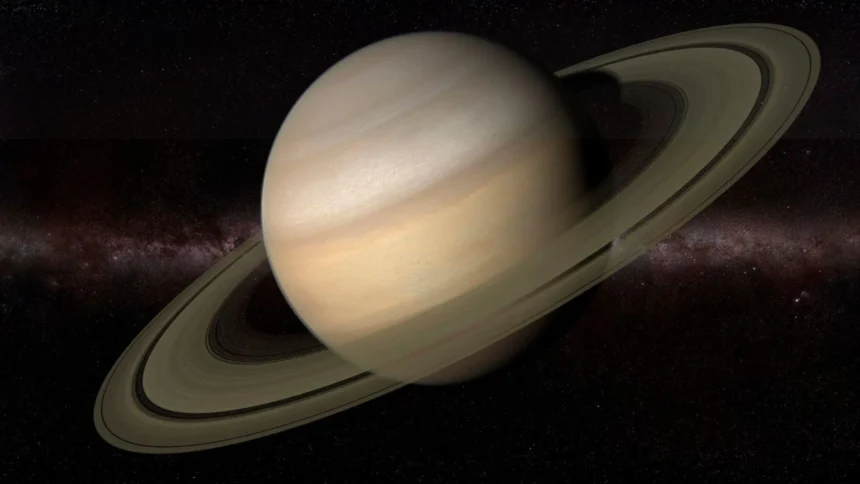What Color is Saturn? Well it depends because the color of Saturn is not only a blurry yellow-brown from Earth, but through telescopes and spacecraft we can observe its base as being pale yellow with touches of orange. On this backdrop, there are faint bands in colors such as yellows, browns and even grays. Sometimes, enormous white storms can burst out, bringing more excitement to this lovely huge planet with rings.
A Hazy View from Earth
When we ask the question “What Color is Saturn” the answer to it can vary because For Earth, Saturn seems like a faraway yellow-brown ball that is not very clear. Two things make this view limited: the big gap in space between us is sometimes hundreds of millions of kilometers.
Secondly, our own atmosphere is like a large lens. It blurs details and scatters sunlight which makes it hard for us to see true colors and intricate features that telescopes or spacecraft can show us.
with Telescopes and Spacecraft
When we try to find out about What Color is Saturn with a telescope we can observe some change in colors. Once a faint dot in the sky, it is now a richly colorful planet thanks to telescopes and spacecraft. Telescopes with great strength can see through the far space barrier and into Saturn’s home.
The images gathered by Cassini, one of many spacecraft sent to explore Saturn’s domain, show its atmosphere in genuine colors: from light yellows and bands that swirl around it to rare sights of blue.
The Base Color of Saturn’s Clouds
The question What Color is Saturn is affected by the cloud factor. Under the moving cloud belts, the main color of Saturn’s top atmosphere is light yellow, occasionally with a hint of orange. It gets this shade from small ammonia crystals that hover in its air.
Saturn has a lot of gas made up mostly by ammonia, and when it gets cold enough there these glasses turn into tiny crystals floating around in space for us to see on its surface like clouds too.
The Cloud Bands
Saturn has a captivating feature of swirling bands of clouds that wrap around the planet. These bands, like Jupiter’s stripes, are not as obvious. They become wider near the equator and have a less lively mix of colors such as yellow, brownish shades and even grayish tones.
While Jupiter flaunts its vibrant reds and oranges, Saturn’s bands display a more subtle mix of hues that suggest intricate atmospheric activities taking place beneath its top layer.
How Light Interacts with Saturn’s Atmosphere
When we ask ourselves What Color is Saturn we should not forget about sunlight. The lovely color changes on Saturn come from the mix of sunlight and atmosphere.
Sunlight touches Saturn in a range of colors, where each one has its own wavelength. When this light interacts with the atmosphere of Saturn, various occurrences take place. Certain wavelengths, for example blues, could be scattered back out to space by tiny particles that are in the atmosphere.
The Mystery of Saturn’s Occasional Bluish Hue
Now and again, when we wonder What Color is Saturn and look at Saturn through the lenses of high-resolution spacecraft pictures, some parts of it show a delicate blue tint. The cause for this unexpected color is possibly linked to how sunlight interacts with methane gas, an element found in abundance within Saturn’s atmosphere. Under certain conditions, methane gas scatters blue wavelengths more efficiently compared to other colors.
When White Takes Center Stage
Similar to the famous largest storm on Jupiter called Great Red Spot, sometimes Saturn also shows big white storms. These giants can be larger than Earth and last for several months. The most well-known example is “Great White Spot,” a massive storm that has been seen many times in past observations of this planet. Curiously, white storms are possibly connected to the seasons of Saturn.
Researchers think these storms might be caused by deep processes in its atmosphere that become more lively at certain times of year, which could contribute an additional dimension of movement within Saturn’s vibrant fabric.
How Colors Change Over Time
The reply to the matter of “What Color is Saturn?” is always changing since Saturn’s atmosphere is not a fixed photograph, but rather a moving canvas. The colors we observe are not stable but rather influenced by sunlight, the mixture of gasses in its atmosphere and strong movements happening there. Sometimes storms can happen too; for instance, the massive white storms can temporarily alter the color scenery. On Saturn, winds blow across the entire globe.
They shape and move cloud bands, changing how colors are spread. Also, changes due to season are seen in “Great White Spot” appearing more often during summer time on Saturn.
The Colorful Rings
When we have discussed all about What Color is Saturn how can we forget the colorful rings. Though attention has been given to Saturn’s atmosphere, it is also important to mention its famous rings. These rings are not like the planet as they mostly consist of water ice and dust particles.
Because of this icy makeup, they have a basic white color. Yet, the story does not stop here. Within the ice, there are little differences made by minerals and organic materials. Some parts can seem yellowish which could be because of compounds with lots of iron in them.
So, what color is Saturn? It’s a lively mix of pale yellows, swirling bands and now and then you can see white or blue. More than just being pleasing to the eye, these colors give us a look into its lively atmosphere suggesting strong storms, changing seasons and perhaps even potential secrets kept by its moons.


Leave a Reply